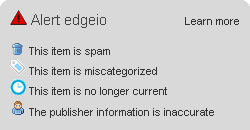Looking at Edgeio
Edgeio has been much touted as a neat web 2.0 application that takes listings a step ahead of the currently prevalent eBay model. I wanted to have a look at how it might have improved on that very successful model.
I was very impressed with one little widget during the sign-up process. The first form element you have to fill in is your username, and then you gradually go down to set a password and give your email address. Even before you submit the form however Edgeio does a look-up and reports back whether your choice of username is available or not.
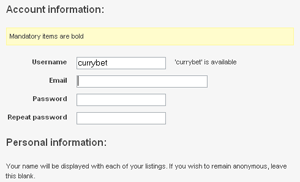
Having recently tried to set up a Yahoo! ID for someone when their choice of username wasn't available, I can tell you from experience that it is frustrating to fill out a lot of details in a form, only to find at the end that your choice of username isn't possible - the Yahoo! form has 12 mandatory fields to negotiate before you find out if your choice of ID is available.
It is in the browse model where Edgeio claim to have really innovated, replacing the static controlled categories of other listings sites with a dynamic taxonomy that should ebb and flow with the content being listed on the site.
The edgeio taxonomy functions like traditional internet taxonomies. A user looking for an Apple iPod, might first choose the category For Sale. Next, they could choose iPod, and finally they might select iPod Nano to get a list of all iPod Nanos listed on edgeio. What makes edgeio different is that we do not define the taxonomy; publishers do by including tags with their items. Using clustered tagging, edgeio is continuously optimizing the taxonomy to match the latest content.
It is just as well they are committed to providing such clear navigational routes, as I found the search functionality to be quite limited on Edgeio. For example, at the time I was testing, a search for 'paris' brought up this item in the results set, simply because, if you look at the text closely, the story was filed in Paris. It isn't about Paris, the story isn't set in Paris, and it isn't even a listing.
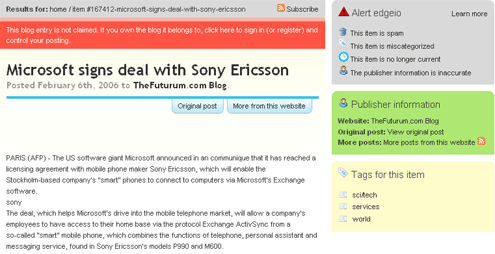
Having recently moved to Greece I am now more than ever interested in how sites handle localisation.
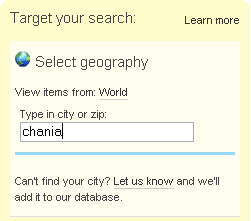
Edgeio tries to handle it gracefully, but I'm not entirely sure it has got it right yet. At the time I was testing it there was nothing at all listed in Greece. The application automatically expands the location out to the first place where there are listings. This meant that when setting my location as Chania in Crete, I was getting EU wide listings as my results. That is a pretty big geographical leap. I'm not convinced when the disparity between the requested location and the location of the listed items is so large that it is worth displaying them to me. The difference between Walthamstow and London, maybe, but the difference between a small town and a geographical block of 25 countries, perhaps not.
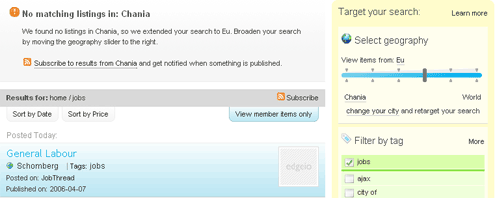
My biggest question about Edgeio though has to be how they intend to prevent it filling up with absolute junk. I'm not sure I can imagine a system more perfectly designed to allow distributed publishers of spam to generate qualified lead clickthroughs onto their sites. They've built some moderation tools into the system for users, but I'm not sure that even the most motivated of user bases can cope with the avalanche of automatically generated blog and comment spam on the internet.
